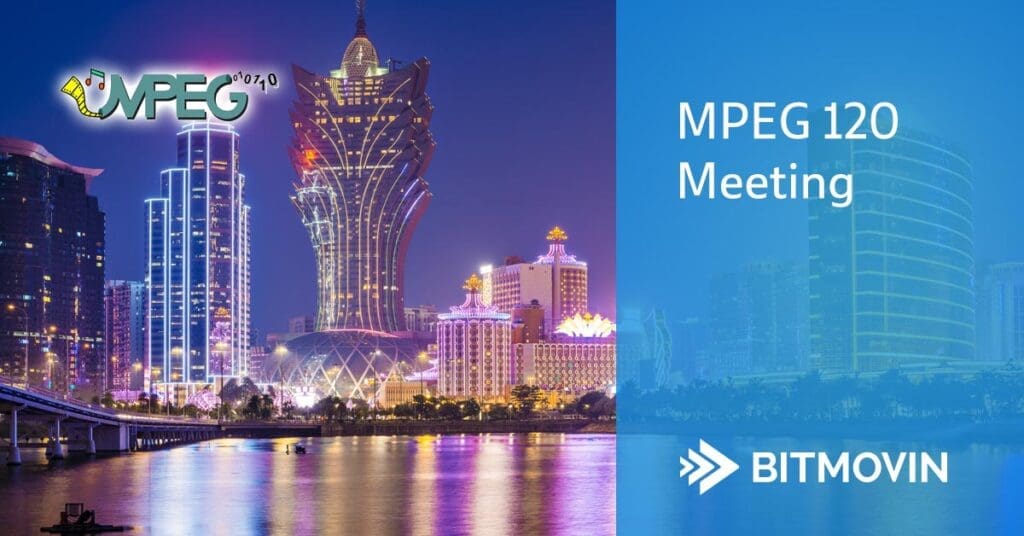
The 120th MPEG meeting concluded on October 27, 2017 in Macau, China with the following topics:
- Point Cloud Compression – MPEG evaluates responses to call for proposal and kicks off its technical work
- The omnidirectional media format (OMAF) has reached its final milestone
- MPEG-G standards reach Committee Draft for compression and transport technologies of genomic data
- Beyond HEVC – The MPEG & VCEG call to set the next standard in video compression
- MPEG adds better support for mobile environment to MMT
- New standard completed for Internet Video Coding
- Evidence of new video transcoding technology using side streams
The corresponding press release of the 120th MPEG meeting can be found here: http://mpeg.chiariglione.org/meetings/120
Point Cloud Compression
At its 120th meeting, MPEG analysed the technologies submitted by nine industry leaders as responses to the Call for Proposals (CfP) for Point Cloud Compression (PCC). These technologies address the lossless or lossy coding of 3D point clouds with associated attributes such as colour and material properties. Point clouds are referred to as unordered sets of points in a 3D space and typically captured using various setups of multiple cameras, depth sensors, LiDAR scanners, etc., but can also be generated synthetically and are in use in several industries. They have recently emerged as representations of the real world enabling immersive forms of interaction, navigation, and communication. Point clouds are typically represented by extremely large amounts of data providing a significant barrier for mass market applications. Thus, MPEG has issued a Call for Proposal seeking technologies that allow reduction of point cloud data for its intended applications. After a formal objective and subjective evaluation campaign, MPEG selected three technologies as starting points for the test models for static, animated, and dynamically acquired point clouds. A key conclusion of the evaluation was that state-of-the-art point cloud compression can be significantly improved by leveraging decades of 2D video coding tools and combining 2D and 3D compression technologies. Such an approach provides synergies with existing hardware and software infrastructures for rapid deployment of new immersive experiences.
Omnidirectional Media Format (OMAF)
The understanding of the virtual reality (VR) potential is growing but market fragmentation caused by the lack of interoperable formats for the storage and delivery of such content stifles VR’s market potential. MPEG’s recently started project referred to as Omnidirectional Media Format (OMAF) has reached Final Draft of International Standard (FDIS) at its 120th meeting. It includes
- equirectangular projection and cubemap projection as projection formats;
- signalling of metadata required for interoperable rendering of 360-degree monoscopic and stereoscopic audio-visual data; and
- provides a selection of audio-visual codecs for this application.
It also includes technologies to arrange video pixel data in numerous ways to improve compression efficiency and reduce the size of video, a major bottleneck for VR applications and services, The standard also includes technologies for the delivery of OMAF content with MPEG-DASH and MMT.
Bitmovin recently received the Excellence in DASH Award for its tile-based streaming of VR and 360-degree video content and also integrated ambisonic audio to enable a truly submersive media experience.
MPEG-G: Compression and Transport Technologies of Genomic Data
The availability of high throughput DNA sequencing technologies opens new perspectives in the treatment of several diseases making possible the introduction of new global approaches in public health known as “precision medicine”. While routine DNA sequencing in the doctor’s office is still not current practice, medical centers have begun to use sequencing to identify cancer and other diseases and to find effective treatments. As DNA sequencing technologies produce extremely large amounts of data and related information, the ICT costs of storage, transmission, and processing are also very high. The MPEG-G standard addresses and solves the problem of efficient and economical handling of genomic data by providing new
- compression technologies (ISO/IEC 23092-2) and
- transport technologies (ISO/IEC 23092-1),
which reached Committee Draft level at its 120th meeting. Additionally, the Committee Drafts for
- metadata and APIs (ISO/IEC 23092-3) and
- reference software (ISO/IEC 23092-4)
are scheduled for the next MPEG meeting and the goal is to publish Draft International Standards (DIS) at the end of 2018.
Beyond HEVC – The MPEG & VCEG Call to set the Next Standard in Video Compression
The 120th MPEG meeting marked the first major step toward the next generation of video coding standard in the form of a joint Call for Proposals (CfP) with ITU-T SG16’s VCEG. After two years of collaborative informal exploration studies and a gathering of evidence that successfully concluded at the 118th MPEG meeting, MPEG and ITU-T SG16 agreed to issue the CfP for future video coding technology with compression capabilities that significantly exceed those of the HEVC standard and its current extensions. They also formalized an agreement on formation of a joint collaborative team called the “Joint Video Experts Team” (JVET) to work on development of the new planned standard, pending the outcome of the CfP that will be evaluated at the 122nd MPEG meeting in April 2018. To evaluate the proposed compression technologies, formal subjective tests will be performed using video material submitted by proponents in February 2018. The CfP includes the testing of technology for 360° omnidirectional video coding and the coding of content with high-dynamic range and wide colour gamut in addition to conventional standard-dynamic-range camera content. Anticipating a strong response to the call, a “test model” draft design is expected be selected in 2018, with development of a potential new standard in late 2020.
Bitmovin products and services support HEVC in addition to AVC and AV1 and looks forward to a bright future in terms of video coding enabling superb quality of experience for end users of adaptive streaming technologies.
MPEG adds Better Support for Mobile Environment to MPEG Media Transport (MMT)
MPEG has approved the Final Draft Amendment (FDAM) to MPEG Media Transport (MMT; ISO/IEC 23008-1:2017), which is referred to as “MMT enhancements for mobile environments”. In order to reflect industry needs on MMT, which has been well adopted by broadcast standards such as ATSC 3.0 and Super Hi-Vision, it addresses several important issues on the efficient use of MMT in mobile environments. For example, it adds distributed resource identification message to facilitate multipath delivery and transition request message to change the delivery path of an active session. This amendment also introduces the concept of a MMT-aware network entity (MANE), which might be placed between the original server and the client, and provides a detailed description about how to use it for both improving efficiency and reducing delay of delivery. Additionally, this amendment provides a method to use WebSockets to setup and control an MMT session/presentation.
New Standard Completed for Internet Video Coding
A new standard for video coding suitable for the internet as well as other video applications, was completed at the 120th MPEG meeting. The Internet Video Coding (IVC) standard was developed with the intention of providing the industry with an “Option 1” video coding standard. In ISO/IEC language, this refers to a standard for which patent holders have declared a willingness to grant licenses free of charge to an unrestricted number of applicants for all necessary patents on a worldwide, non-discriminatory basis and under other reasonable terms and conditions, to enable others to make, use, and sell implementations of the standard. At the time of completion of the IVC standard, the specification contained no identified necessary patent rights except those available under Option 1 licensing terms. During the development of IVC, MPEG removed from the draft standard any necessary patent rights that it was informed were not available under such Option 1 terms, and MPEG is optimistic of the outlook for the new standard. MPEG encourages interested parties to provide information about any other similar cases. The IVC standard has roughly similar compression capability as the earlier AVC standard, which has become the most widely deployed video coding technology in the world. Tests have been conducted to verify IVC’s strong technical capability, and the new standard has also been shown to have relatively modest implementation complexity requirements.
Evidence of new video transcoding technology using side streams
Following a “Call for Evidence” (CfE) issued by MPEG in July 2017, evidence was evaluated at the 120th MPEG meeting to investigate whether video transcoding technology has been developed for transcoding assisted by side data streams that is capable of significantly reducing the computational complexity without reducing compression efficiency. The evaluations of the four responses received included comparisons of the technology against adaptive bit-rate streaming using simulcast as well as against traditional transcoding using full video re-encoding. The responses span the compression efficiency space between simulcast and full transcoding, with trade-offs between the bit rate required for distribution within the network and the bit rate required for delivery to the user. All four responses provided a substantial computational complexity reduction compared to transcoding using full re-encoding. MPEG plans to further investigate transcoding technology and is soliciting expressions of interest from industry on the need for standardization of such assisted transcoding using side data streams.




